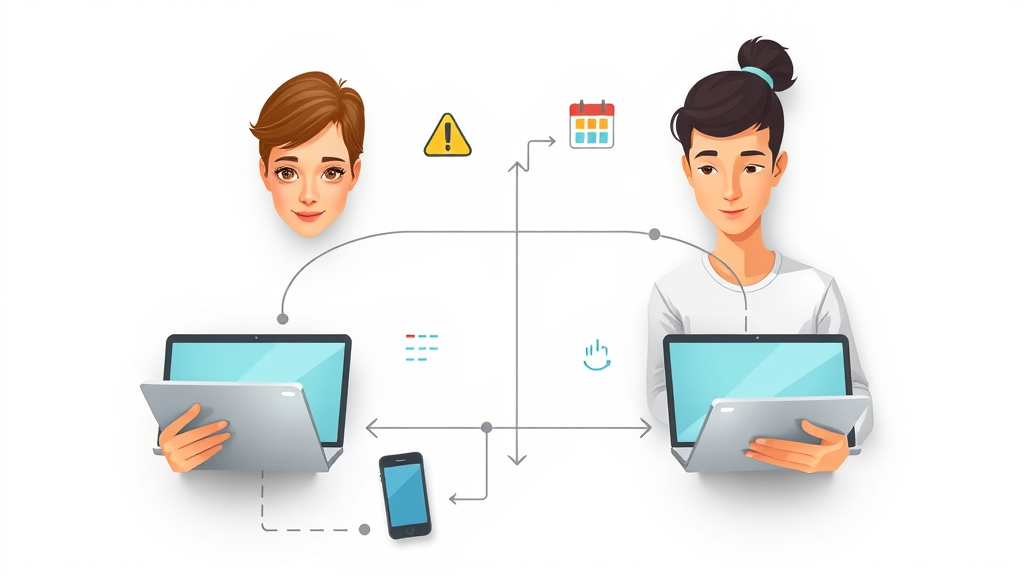Did you know that companies implementing cross-channel campaign optimization strategies can experience up to a 35% increase in their marketing ROI compared to those relying on a single channel? The marketing landscape is shifting rapidly, and brands that want to deliver outstanding results must harness the power of cross-channel campaign optimization. In this guide, you’ll uncover why connecting your marketing channels is no longer optional, but essential for achieving higher engagement, stronger brand identity, and smarter campaign management. Let’s explore the proven steps and modern techniques to unlock your full marketing potential across every channel.
Cross-Channel Campaign Optimization: The Data-Driven Edge in Modern Channel Marketing
Cross-channel campaign optimization isn’t just a trending buzzword—it’s quickly becoming the backbone of effective channel marketing and marketing strategy . By blending customer data, integrating messaging, and leveraging campaign management tools across multiple channels , modern marketers gain an unprecedented edge. The ability to tailor, coordinate, and optimize campaigns leads to improved customer engagement, higher conversion rates, and better ROI.
A campaign that leverages cross-channel optimization recognizes that today’s customers interact with brands in diverse ways—via email marketing , social media , mobile apps, push notifications, and more. Rather than treating each channel as a silo, successful organizations synchronize their efforts to create a seamless customer journey. Imagine engaging a customer who receives an email offer, sees related posts on social media, and then gets a personalized push notification—each touchpoint reinforcing the others. Salesforce research states that customers are much more likely to purchase when they and their preferences are recognized across multiple channels. This is the new frontier of channel marketing, where smart integration and real-time data create remarkable marketing campaigns.

"Companies that implement cross-channel campaign optimization strategies see up to a 35% lift in marketing ROI compared to single-channel campaigns."
Unlocking the Potential: What You’ll Learn about Cross-Channel Campaign Optimization
-
How cross-channel campaign optimization drives superior campaign management
-
Benefits of a unified channel marketing strategy
-
Ways to use customer data for channel optimization
-
Steps to increase conversion rates across marketing channels
-
Actionable tips to measure and improve campaign performance
Understanding Cross-Channel Campaign Optimization in Channel Marketing Strategy
Defining Cross-Channel Campaign Optimization: Integrating Multiple Marketing Channels
Cross-channel campaign optimization means coordinating your marketing efforts across a variety of channels—like email, social media, and mobile apps—to provide a flowing and consistent brand message wherever your customers interact. This integration ensures that your campaign management delivers a consistent brand experience, regardless of the platform. Importance lies in using real-time customer data to understand how each channel contributes to the customer journey and then adjusting campaigns for maximum impact.
For example, a retail brand might send an initial email marketing campaign, reinforce the message with social media ads, and encourage a store visit with a personalized push notification. This layered, coordinated approach not only boosts customer engagement but also increases the likelihood of a successful conversion. In cross-channel optimization, each channel amplifies the influence of the others, creating momentum that is nearly impossible through single-channel marketing efforts.
Key Differences: Cross-Channel vs. Omnichannel Marketing
While the terms cross-channel and omnichannel marketing are often used interchangeably, they differ in strategy and execution. Cross-channel focuses on synchronizing marketing efforts across platforms—ensuring messaging is aligned so customers enjoy a cohesive experience as they move from one touchpoint to another. Omnichannel , however, goes a step further, aiming for a completely unified and seamless interaction by linking data and customer insights across every channel for a more holistic experience.
Understanding these nuances is essential for marketers aiming to deliver a seamless customer journey and boost overall campaign performance. The table below outlines these differences for clarity:
|
|
|
Comparison of Cross-Channel vs. Omnichannel Approaches |
|
Aspect |
Cross-Channel |
Omnichannel |
|---|---|---|
|
Objective |
Synchronized messaging |
Unified experience |
|
Data Sharing |
Partial |
Complete |
|
Example |
Coordinated email and social campaigns |
Seamless website-to-app transitions |

Why Cross-Channel Campaign Optimization Is Essential for a Winning Marketing Strategy
Enhancing Customer Engagement Across Multiple Channels
Modern consumers expect brands to know them and meet them where they are. By adopting cross-channel campaign optimization , companies can deliver highly targeted messages at the right moment, no matter the platform. This strategy increases touchpoints and lets your brand reach customers in ways that matter most to them—whether it’s a social media reminder, an email newsletter, or a push notification on their phone.
The result? Markedly higher customer engagement due to reinforcing messages and offers across the channels where your audience is most active. With more frequent, strategic touchpoints, your campaigns become harder to ignore, inspiring not only more opens and clicks but deeper loyalty over time.
Driving Higher Conversion Rates and Campaign Performance
Cross-channel campaign optimization directly impacts conversion rates by presenting messaging that feels relevant and timely. When marketing messages are reinforced and personalized, customers are much more likely to take the desired action—whether that’s signing up for a webinar or making a purchase. As different channels work together, they create multiple opportunities for customers to interact with your brand, increasing the likelihood of conversion at each stage of the customer journey .
Continually monitoring campaign performance across touchpoints gives teams the data needed to refine and adjust messaging for even greater results. When a social media campaign performs well, its insights can inform your next email blast or in-app notification, creating a powerful feedback loop that drives campaign improvement.
Maximizing Customer Journey Touchpoints
Each step of the customer journey —from awareness to purchase and beyond—offers fresh opportunities for engagement through different channels. Cross-channel campaign optimization enables marketers to map customer behavior, pinpoint critical touchpoints, and deliver consistent messaging that moves prospects forward.
By identifying which touchpoints are crucial for nurturing leads or closing sales, you can build marketing campaigns that maximize impact at every phase, ensuring the journey remains fluid and interconnected. This optimized approach not only improves campaign management but also helps extend the customer lifetime value —the ultimate measure of channel marketing strategy success.

Channel Optimization: Building a Cohesive Channel Marketing Strategy
Selecting the Optimal Marketing Channels for Your Audience
Every successful channel marketing strategy begins with knowing where your customers spend their time. By analyzing customer data on demographics, engagement patterns, and purchase behavior, marketers can select the most effective marketing channels—be it social media, email, SMS, or newer platforms like messaging apps and push notifications.
Choosing the right mix of platforms enables you to deliver personalized messages to customers where they’re most receptive. It’s about allocating resources wisely—if your audience prefers Instagram Stories over traditional email marketing, prioritize accordingly. This tailored approach forms the backbone of effective channel optimization and increases the reach of your marketing campaigns.

Mapping the Customer Journey for Superior Campaign Management
Understanding and visualizing the customer journey is foundational for advanced campaign management . Map all customer interactions, from the first encounter with your brand to final purchase and post-sale engagement. Identify pain points or opportunities where prospects drop off or stall.
Integrated tools can help create a customer journey map, revealing channel preferences at each stage. With this insight, your team can optimize messaging and offers to drive prospects toward the next logical step. The result is a channel marketing program that guides customers through a planned, cohesive experience.
Orchestrating Content Across Marketing Campaigns
High-performing marketing campaigns rely on consistent, creative content distributed across all channels. Develop a central content calendar and ensure each piece aligns with both your brand voice and specific channel requirements. Coordinated efforts—like launching a product update through blogs, social media, email, and push notifications on the same day—amplify reach and engagement.
Don’t forget that what works on one channel may not suit another. Tailor messaging and format for each platform, maintain consistent messaging throughout, and keep content updated based on campaign performance data. This orchestration ensures target customers receive relevant, impactful information wherever they interact with your brand.
Leveraging Customer Data for Cross-Channel Campaign Optimization
Gathering and Integrating Customer Data Across Marketing Channels
Data is the lifeblood of cross-channel campaign optimization. Start by collecting customer data from every marketing channel —web analytics, CRM, email open rates, social media behavior, purchase history, and direct customer feedback. Integrating this data into a single platform gives you a holistic understanding of each customer’s preferences and journey.
Modern channel optimization tools help manage and analyze vast data streams, revealing patterns and allowing for real-time adjustment of campaigns. An integrated approach ensures that every action a customer takes—no matter the channel—is captured, analyzed, and translated into insights for smarter campaign management.

Personalization at Scale: Enhancing the Customer Experience
With rich, integrated customer data , brands can achieve personalization at scale—offering tailored messages, offers, and experiences unique to each user. Personalization boosts customer experience by making every interaction feel relevant and timely. Segment customers based on behavior, preferences, and lifecycle stage, and craft campaigns that adapt to their specific needs.
For example, a customer who abandoned a shopping cart might receive a reminder via email, followed by a personalized offer on social media and a push notification with exclusive incentives. By using automation and insights, you can nurture relationships, increase conversions, and foster lasting loyalty.
Real-Time Adjustments and Campaign Management Using Analytics
The hallmark of effective cross-channel campaign optimization is the ability to adjust on the fly. Marketing platforms now offer analytics dashboards that track campaign performance metrics like conversion rate, engagement, and lifetime value in real time. Harness this data to optimize live campaigns and reroute resources to what’s working best.
Real-time campaign management means responding to shifts in customer behavior—the channels or touchpoints where customers engage more or less than expected. If push notifications suddenly outperform email, shift your budget and attention accordingly. Proactive adjustments ensure your marketing strategy stays agile and effective.
Best Practices for Effective Cross-Channel Campaign Optimization
-
Align messaging across channels and platforms
-
Use customer data to tailor touchpoints on the customer journey
-
Monitor campaign performance metrics for continuous channel optimization
-
Leverage automation for seamless campaign management
Measuring Success: Key Metrics in Campaign Performance and Channel Marketing
Tracking Conversion Rate and Customer Engagement
The ultimate test of your marketing campaigns lies in measurable outcomes. Tracking metrics like conversion rate and engagement rate helps you assess if your channel marketing strategy is driving action and building relationships. Monitor which channels deliver the best open rates, most interactions, and ultimately, the highest return on investment.
Use tagging, tracking codes, and analytics platforms to measure response rates across all touchpoints. This granular view empowers you to double down on what works and improve what doesn’t—creating a data-driven cycle of constant improvement in campaign performance .

KPIs for Channel Optimization: Beyond Clicks and Opens
Going deeper than basic metrics means considering outcomes like customer lifetime value , repeat purchase rates, and channel attribution modeling. Together, these numbers show how well your cross-channel optimization is working—not just for single-campaign success, but for sustainable, long-term growth.
Review the table below for essential metrics to guide your strategy:
|
|
|
Essential Metrics for Cross-Channel Campaign Optimization |
|
Metric |
Description |
Why It Matters |
|---|---|---|
|
Conversion Rate |
% of users taking desired action |
Measures effectiveness |
|
Engagement Rate |
Interactions per channel |
Indicates channel success |
|
Customer Lifetime Value |
Value from a customer over time |
Aligns strategy with ROI |
Campaign Management Techniques for Advanced Cross-Channel Campaign Optimization
Integrating Multiple Channels for Cohesive Marketing Campaigns
True cross-channel campaign optimization means more than running ads on several platforms—it’s about creating a unified experience across all channels. Integrate your campaign management efforts so messages, visuals, and offers remain consistent whether a customer sees you on Instagram, receives your email newsletter, or hears from a sales rep.
This coordination is best achieved with regular communication between marketing, sales, and customer service teams, alongside a strategy that documents each touchpoint. Successful brands use shared calendars, workflow tools, and centralized data dashboards to ensure every team member sees the full picture and adapts campaigns in real time.

Tools and Platforms to Streamline Channel Optimization
Modern campaign management requires the right toolkit. Use marketing automation platforms that can segment audiences, tailor messaging, and deliver insights for real-time optimization. Consider platforms with robust analytics, easy integration, and multi-channel orchestration—like Salesforce, HubSpot, or Marketo.
Additionally, leverage AI-powered analytics tools for ongoing channel strategy improvement and campaign personalization. The right technology stack makes it easy to launch, manage, and refine campaigns with confidence, giving you the agility needed to respond to changing customer behavior and preferences.
Maximizing the Customer Experience with Seamless Cross-Channel Marketing
Creating a Seamless Customer Journey
Customers crave seamless, interruption-free experiences as they move between your channels. Cross-channel campaign optimization ensures customers never feel lost—every message, recommendation, and offer connects smoothly from one point to the next. When customers can start a purchase on their mobile phone, continue research on a laptop, and finish in-store or via app, their perception of your brand soars.
A seamless customer journey boosts trust, reduces friction, and keeps your brand top of mind, ultimately leading to higher loyalty and greater customer lifetime value.

Aligning Touchpoints to Increase Customer Loyalty
Strategic alignment of touchpoints is at the heart of an effective channel marketing strategy. Whether a touchpoint is a targeted social media ad, a push notification with an exclusive offer, or in-store support, each customer interaction must reinforce your key brand values and messaging.
Consistent touchpoint integration leads to familiarity, trust, and—over time—deep loyalty. Use consistent branding, personalized offers, and responsive service to turn casual interactions into meaningful, ongoing relationships.
Real-World Examples of Effective Channel Marketing Strategy and Cross-Channel Campaign Optimization
Case Study: Retail Success with Integrated Channel Strategy
A popular fashion retailer sought to increase sales both online and in-store. They synced email marketing campaigns with social and push notifications, targeting customers with personalized deals based on purchase history. Digital displays in-store featured product recommendations matching recent email content, while the mobile app made it easy to find and buy those items.
Result: Conversion rates and average order values surged, with a marked increase in cross-device purchases and stronger customer loyalty. The fully integrated channel marketing strategy transformed a fragmented campaign into a seamless customer journey.

Case Study: B2B Expansion through Multichannel Marketing Approach
A leading B2B software provider wanted to reach customers in multiple industries and geographies. They adopted a multichannel marketing approach—combining webinars, email outreach, LinkedIn campaigns, and targeted digital advertising. Using centralized campaign management , they gathered customer data to refine and personalize messaging at each stage of the sales funnel.
The company saw double-digit growth in lead generation and conversion rate, proving that cross-channel campaign optimization is just as effective for B2B channel marketing as it is for retail.
Top Challenges in Cross-Channel Campaign Optimization and How to Overcome Them
Breaking Down Data Silos in Marketing Channel Integration
One of the biggest hurdles is the presence of data silos —when customer data and campaign results live in disconnected systems across an organization. These silos make it hard to build an accurate, unified view of the customer journey , making optimization and personalization difficult.
To overcome this, invest in centralized data platforms that aggregate inputs from every marketing channel , allowing for faster decisions and more sophisticated customer segmentation. Unified data not only powers better campaign management but unlocks new opportunities for personalization.
Maintaining Consistency Across Marketing Campaigns
Another challenge lies in keeping consistent messaging and brand voice as you scale outreach across multiple channels. When separate teams create content independently, the customer experience can become confusing or even contradictory.
Combat this through clear style guides, template libraries, and coordinated content planning processes. Shared analytics dashboards and collaboration tools also ensure everyone’s working from the same data, driving a truly integrated channel marketing execution.
-
Data fragmentation
-
Attribution complexity
-
Technology integration hurdles
-
Resource allocation
People Also Ask: Cross-Channel Campaign Optimization Insights
What is cross-channel optimization?
Answer
Cross-channel optimization is the practice of coordinating and refining your marketing campaigns across multiple platforms to deliver a unified message, leverage customer data, and maximize engagement. This approach ensures that no matter how customers interact with your brand—be it via email, social media, push notifications, or in-store—the messaging and experience feel consistent, personalized, and responsive. The result is improved campaign performance, higher conversion rates, and a better overall customer journey.
People Also Ask: Understanding the Nuances of Cross-Channel Campaigns
What is a cross-channel campaign?
Answer
A cross-channel campaign is a marketing effort that intentionally utilizes more than one platform to reach and engage customers. For instance, a brand might combine social media ads, email newsletters, and push notifications to promote a product launch. By syncing content and timing across channels, these campaigns are designed to reinforce messaging, increase touchpoints along the customer journey, and drive higher engagement and conversions.
People Also Ask: Examples and Methods of Channel Optimization
What is an example of channel optimization?
Answer
A classic example of channel optimization would be a brand that uses customer data to identify the best channels for each audience segment—targeting busy professionals with SMS reminders and social media ads, while reaching older customers through personalized email marketing. The brand continuously monitors campaign performance and reallocates resources to the channels with the best results, ensuring each customer interaction is relevant and timely.
People Also Ask: Difference Between Cross-Channel and Omnichannel Marketing
What is the difference between cross-channel and omnichannel?
Answer
While cross-channel marketing focuses on coordinating messages across various platforms to create a logical customer journey, omnichannel marketing takes it a step further by ensuring all channels are interconnected for a truly seamless, data-driven experience. Omnichannel marketing allows customers to start an interaction on one channel and finish on another without any disruption or loss of context, giving brands an unmatched ability to deliver personalized service and adapt to evolving customer needs.
Frequently Asked Questions about Cross-Channel Campaign Optimization
-
How often should campaign management be reviewed in a cross-channel marketing strategy?
For the best results, review and adjust your campaign management weekly. An agile approach allows your team to quickly adapt to changing customer behavior and channel performance. -
Which marketing channels are most effective for cross-channel campaign optimization?
The most effective channels depend on your audience. However, email, social media, SMS, and in-app notifications are commonly successful. Analyze customer data to find which platforms your customers prefer. -
How does customer engagement differ between single-channel and cross-channel strategies?
Cross-channel campaigns drive significantly higher engagement, as they give multiple tailored opportunities for interaction. Single-channel efforts risk missing customers where they spend the most time. -
What tools can help streamline channel optimization and improve campaign performance?
Marketing automation platforms like HubSpot, Salesforce, and Marketo, along with comprehensive analytics tools like Google Analytics and Tableau, streamline optimization and performance monitoring. -
How do you measure the success of cross-channel marketing campaigns?
Success is measured using metrics such as conversion rate, engagement rate, customer lifetime value, and channel-specific return on investment. Regular analysis ensures campaigns are optimized for maximum impact.
Implementing Your Winning Channel Marketing Strategy
-
Start by auditing your current marketing channels
-
Integrate customer data to personalize the customer journey
-
Focus on campaign management best practices for sustained success
-
Leverage technology to unify marketing campaigns
"Cross-channel campaign optimization isn’t just a trend—it’s the backbone of future-ready channel marketing strategies."
Next Steps: Supercharge Results with Cross-Channel Campaign Optimization
Take action today by evaluating your current channels, integrating your data platforms, prioritizing seamless customer experiences, and leveraging advanced campaign management tools. Unlock the full potential of your channel marketing strategy through true cross-channel campaign optimization!
To deepen your understanding of cross-channel campaign optimization, consider exploring the following resources:
Struggling to make All of your marketing strategies work together seamlessly and effortlessly? Omni-Channel or Cross-Channel, they Start with Content. Click the Link and Get our Ultimate Guide for Building a Content Marketing Strategy for Small Business..
-
“Cross-Channel Advertising: Challenges & Strategies (With an Example)” ( optmyzr.com )
This article provides a comprehensive roadmap for navigating cross-channel pay-per-click (PPC) advertising, including platform-specific content creation, centralized analytics, and synchronized campaign launches.
-
“What is Cross-Channel Marketing?” ( optimine.com )
This resource offers practical tips and best practices for developing and optimizing a successful cross-channel marketing strategy, emphasizing the importance of understanding your audience, creating consistent branding, and integrating technology and automation.
By delving into these articles, you’ll gain actionable insights and strategies to enhance your cross-channel marketing efforts, leading to improved customer engagement and higher ROI.
 Add Row
Add Row  Add
Add 




Write A Comment